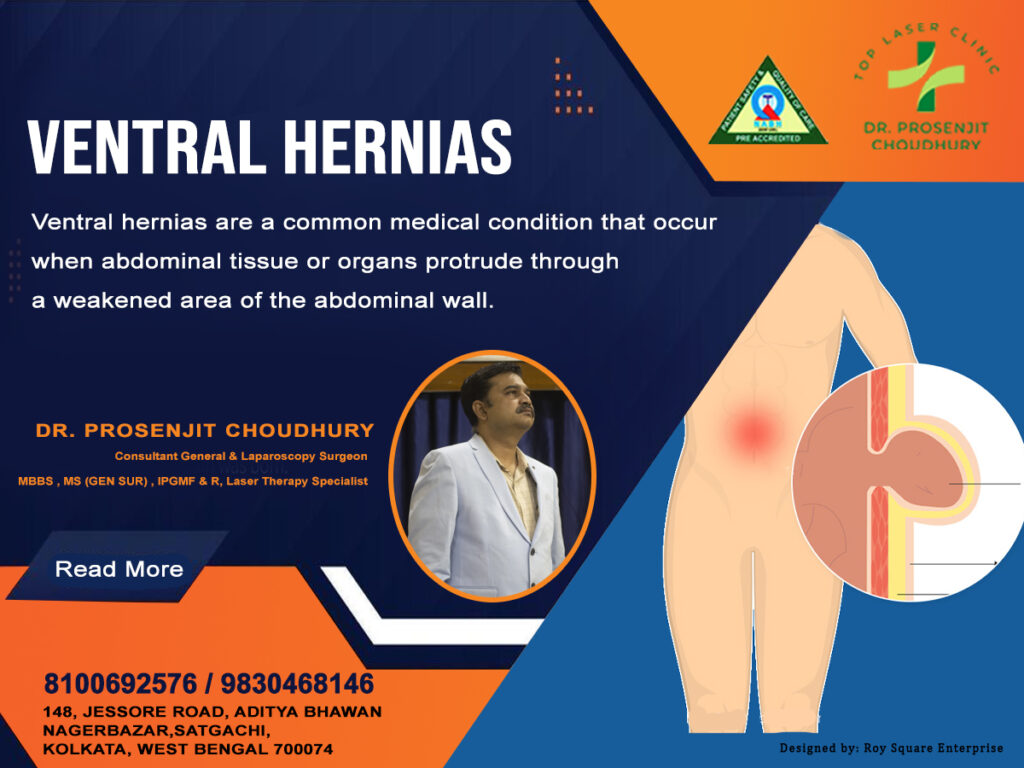Ventral Hernias

Ventral hernias are a common medical condition that occur when abdominal tissue or organs protrude through a weakened area of the abdominal wall. While they may not always cause immediate discomfort, ventral hernias can lead to serious complications if left untreated. In this blog post, we will explore the causes, symptoms, and treatment options for ventral hernias to help you better understand this condition.
Causes:
Ventral hernias can develop due to a variety of factors that weaken the abdominal wall. Some of the common causes include:
- Surgery: Previous abdominal surgeries, such as appendectomies or hernia repairs, can leave weakened areas in the abdominal wall, increasing the risk of hernias.
- Obesity: Excess weight puts additional pressure on the abdominal wall, making it more likely to develop hernias.
- Pregnancy: The stretching of the abdominal muscles during pregnancy can weaken the abdominal wall, leading to hernias.
- Chronic coughing or straining: Conditions such as chronic obstructive pulmonary disease (COPD) or constipation that require frequent straining can contribute to the development of hernias.
- Genetics: Some people may inherit a predisposition to developing hernias due to genetic factors.
Symptoms:
The symptoms of ventral hernias can vary depending on the size and location of the hernia. Common symptoms include:
- Visible bulge: A noticeable bulge or lump in the abdomen, especially when standing or straining.
- Pain or discomfort: Pain or aching at the site of the hernia, which may worsen with activity or lifting heavy objects.
- Nausea and vomiting: In some cases, a hernia can cause digestive problems such as nausea, vomiting, or difficulty passing stool.
- Redness or swelling: The area around the hernia may become red, swollen, or tender to the touch if the hernia becomes incarcerated or strangulated.
Treatment:
The treatment for ventral hernias typically involves surgical repair to strengthen the abdominal wall and prevent further protrusion of abdominal tissue or organs. The type of surgery recommended will depend on the size and severity of the hernia, as well as the patient’s overall health. Some common surgical options include:
- Open Hernia Repair: In this traditional approach, the surgeon makes an incision near the hernia site, pushes the protruding tissue back into place, and then repairs the weakened abdominal wall using stitches or a synthetic mesh.
- Laparoscopic Hernia Repair: This minimally invasive technique involves making several small incisions in the abdomen and using a tiny camera (laparoscope) and specialized surgical instruments to repair the hernia. This approach typically results in faster recovery times and less postoperative pain compared to open surgery.
- Robotic Hernia Repair: Similar to laparoscopic surgery, robotic-assisted hernia repair utilizes robotic arms controlled by the surgeon to perform the procedure with enhanced precision and dexterity.
Ventral hernias are a common medical condition that can cause discomfort and complications if left untreated. By understanding the causes, symptoms, and treatment options for ventral hernias, individuals can make informed decisions about their healthcare and seek timely medical attention if needed. If you suspect you have a ventral hernia or are experiencing symptoms suggestive of one, it is important to consult with a healthcare professional for proper evaluation and management.

Tricks to Avoid Hernia
Preventing hernias involves taking measures to strengthen the abdominal wall and minimize factors that contribute to weakening it. While not all hernias can be completely prevented, following these guidelines can reduce your risk:
- Maintain a healthy weight: Excess weight puts additional strain on the abdominal muscles, increasing the risk of hernias. Keep your weight in check with a well-balanced diet and frequent exercise.
- Practice proper lifting techniques: When lifting heavy objects, bend your knees and use your leg muscles to lift, rather than straining your back and abdominal muscles. Avoid lifting objects that are too heavy for you to handle alone.
- Avoid constipation and straining: Eat a high-fiber diet, drink plenty of water, and exercise regularly to prevent constipation. Straining during bowel movements can weaken the abdominal wall, so it’s important to address any digestive issues promptly.
- Strengthen your core muscles: Engage in exercises that target the core muscles, such as planks, crunches, and pelvic tilts. Strengthening these muscles can help support the abdominal wall and reduce the risk of hernias.
- Quit smoking: Smoking can weaken the connective tissues in the body, including those in the abdominal wall. Quitting smoking can improve overall health and reduce the risk of hernias.
- Avoid rapid weight gain or loss: Rapid changes in weight can put stress on the abdominal muscles and increase the risk of hernias. Aim for gradual, sustainable weight loss or gain, and avoid crash diets or extreme fluctuations in weight.
- Use proper posture: Maintaining good posture can help distribute weight evenly and reduce strain on the abdominal muscles. Practice standing and sitting with your shoulders back, chest lifted, and abdomen engaged.
- Treat underlying medical conditions: Conditions such as chronic coughing, COPD, or frequent urinary retention can increase abdominal pressure and contribute to hernias. Seek treatment for any underlying medical conditions to reduce strain on the abdominal wall.
- Wear supportive clothing: Avoid wearing tight or restrictive clothing that puts pressure on the abdomen. Opt for supportive undergarments or belts when engaging in activities that involve heavy lifting or strenuous exercise.
- Be mindful during pregnancy: While pregnancy itself can increase the risk of hernias due to abdominal muscle stretching, maintaining good posture, exercising safely, and avoiding excessive weight gain during pregnancy can help minimize the risk.
By incorporating these preventive measures into your lifestyle, you can help reduce your risk of developing hernias and maintain a strong and healthy abdominal wall. If you have specific concerns or risk factors for hernias, consult with a healthcare professional for personalized advice and guidance.
Hernia vs Appendix

Hernia and appendix are two distinct medical conditions that affect different parts of the body and have different causes, symptoms, and treatments. Below is a summary of the main distinctions between them:
1. Location:
• Hernia: A hernia occurs when an organ or tissue protrudes through a weakened spot in the abdominal wall. Common types of hernias include inguinal hernias (in the groin area), umbilical hernias (around the belly button), and hiatal hernias (in the upper stomach).
• Appendix: The appendix is a small, tube-like organ located at the junction of the small intestine and the large intestine in the lower right side of the abdomen.
2. Cause:
• Hernia: Hernias are typically caused by factors that weaken the abdominal wall, such as previous abdominal surgeries, obesity, pregnancy, heavy lifting, or chronic coughing.
• Appendix: Appendicitis, the inflammation of the appendix, is the most common cause of appendicitis. It is often due to an obstruction in the appendix, usually by fecal matter, leading to bacterial overgrowth and inflammation.
3. Symptoms:
• Hernia: Common symptoms of a hernia include a visible bulge or lump in the affected area, pain or discomfort (especially when lifting or straining), nausea, vomiting, and a feeling of heaviness or pressure in the abdomen.
• Appendix: Symptoms of appendicitis may include abdominal pain that starts near the belly button and migrates to the lower right abdomen, loss of appetite, nausea, vomiting, fever, and abdominal tenderness.
4. Treatment:
• Hernia: Treatment for hernias often involves surgical repair to strengthen the weakened area of the abdominal wall and prevent further protrusion of organs or tissue. Surgical options may include open hernia repair, laparoscopic hernia repair, or robotic-assisted hernia repair.
• Appendix: Appendicitis is typically treated with surgery to remove the inflamed appendix, a procedure known as an appendectomy. In some cases, antibiotics may be given before surgery if the appendix has not ruptured.
In summary, while both hernias and appendicitis involve abdominal discomfort and may require surgical intervention, they are distinct conditions with different causes and treatment approaches. Hernias involve the protrusion of organs or tissue through a weakened abdominal wall, while appendicitis is inflammation of the appendix, often due to obstruction and bacterial infection. If you experience symptoms suggestive of either condition, it’s important to seek medical attention promptly for proper diagnosis and treatment.
Rare Types of Hernia
While inguinal and umbilical hernias are widely recognized, there are lesser-known types of hernias that can also occur. We will discuss briefly about three less common types of hernias: omentum hernia, infraumbilical hernia, and Swiss cheese defect hernia. Understanding these hernia variations is crucial for recognizing their symptoms and seeking appropriate treatment.
1. Omentum Hernia:
• Overview: Omentum hernias involve the protrusion of the omentum, a fatty tissue layer that covers the abdominal organs, through a weakened area of the abdominal wall.
• Causes: Omentum hernias can occur due to factors such as obesity, previous abdominal surgeries, or trauma to the abdomen.
• Symptoms: Common symptoms may include a visible bulge or lump in the abdomen, discomfort or pain, especially when bending or lifting, and digestive symptoms if the herniated omentum becomes trapped or twisted.
• Treatment: Surgical repair is typically recommended to address omentum hernias, with the goal of strengthening the abdominal wall and preventing further protrusion of the omentum.
2. Infraumbilical Hernia:
• Overview: Infraumbilical hernias occur below the umbilicus (belly button) and involve the protrusion of abdominal contents through a weakened area of the lower abdominal wall.
• Causes: Weakness in the abdominal wall in the infraumbilical region can develop due to factors such as obesity, pregnancy, or previous abdominal surgeries.
• Symptoms: Symptoms may include a visible bulge or lump below the umbilicus, discomfort or pain, especially with physical activity, and potential digestive symptoms if organs become trapped or obstructed.
• Treatment: Surgical repair is the primary treatment for infraumbilical hernias, aiming to reinforce the weakened abdominal wall and prevent further protrusion of abdominal contents.
3. Swiss Cheese Defect Hernia:
• Overview: Swiss cheese defect hernias, also known as multiple defect hernias, involve multiple small defects or weaknesses in the abdominal wall, resembling the appearance of Swiss cheese.
• Causes: The exact cause of Swiss cheese defect hernias is not always clear but may be related to congenital factors, chronic abdominal strain, or previous surgeries.
• Symptoms: Symptoms can vary depending on the size and location of the defects but may include visible bulges or lumps in multiple areas of the abdomen, discomfort or pain, and potential complications if organs become trapped or obstructed.
• Treatment: Surgical repair of Swiss cheese defect hernias may involve addressing each individual defect to strengthen the abdominal wall comprehensively.
While inguinal and umbilical hernias are well-known, it’s essential to recognize that other types of hernias, such as omentum hernia, infraumbilical hernia, and Swiss cheese defect hernia, can also occur. Understanding the causes, symptoms, and treatment options for these less common hernia variations is crucial for prompt diagnosis and appropriate management. If you suspect you have a hernia or are experiencing symptoms suggestive of one, it’s important to consult with a healthcare professional for proper evaluation and personalized treatment recommendations. Early intervention can help prevent complications and improve outcomes for individuals living with hernias, regardless of their type.